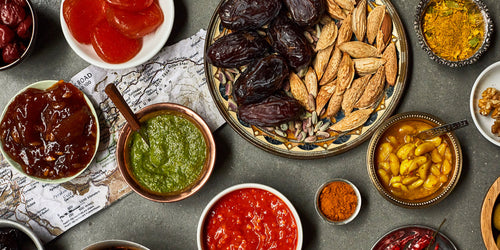Your Cart is Empty

For the last 10 years, Louisa Shafia has been one of the country’s leading ambassadors to Persian cuisine. While her first cookbook, Lucid Food, focused on themes of environmental consciousness through cooking, the recipes show an indelible Iranian imprint: fresh vegetables above all else, loads of herbs, tart and bright spices, and luscious baked fruits. In 2013 she went all-out with The New Persian Kitchen, a modern interpretation of Persian classics, such as a sheet-pan roast chicken rubbed with turmeric and sumac. In between and in the years following, she’s contributed dozens of articles and recipes on Persian cooking to publications like the Wall Street Journal, Saveur, and Bon Appetit.
In other words, she’s the kind of cook you’d trust to make a gorgeous rice bonnet to protect your rice as it steams in a pot—which she sells through her website.
We chatted with Shafia about the essential Persian ingredients she keeps in her pantry at all times—the saffron, rose water, and dried limes she relies on to make fragrant rice pilafs, herb-festooned omelets, and walnut-thickened stews. Here are her tips for stocking your own Persian pantry, in her own words. — Caravan eds.
Louisa’s Persian Essentials
Saffron
This is the most iconic Persian ingredient, and while it’s generally agreed upon that Iranian saffron is the best, it can be hard to get, and there’s good saffron grown in several places. We use it in rice dishes; marinades for kebabs with yogurt, garlic, and lemon juice; a lot of desserts like rice pudding ice cream; and a few stews. Shop saffron.
Sumac
The whole Persian palate is very into tartness and brightness, and there’s always a shaker of sumac on the table or in any kebab platter. It should be a deep red color, and if it’s nice and fresh it’ll be clumpy and moist with a good fruity smell. Sumac is just one way to add sourness; there’s also sour cherries, pomegranates, verjus, tamarind, and sour plums. Shop sumac.
Pomegranate molasses
One of the most iconic Persian stews is fasenjun, which was originally made with duck but can also use chicken, turkey, lamb, or beef. It gets its body from pomegranate juice that’s cooked down into a syrup. You can find many different brands; I prefer the ones with no added sugar, so all you taste is pomegranate. Shop pomegranate molasses.
Tamarind paste
In southern Iran there’s this iconic dish, ghalieh mahi, made with tamarind and fish. You want pure tamarind puree: just tamarind and water. Shop tamarind paste.

Dried limes
They’re like a lime times ten. You’re not just getting the flesh, but also the skin. We use them in stews like ghormeh sabzi, tomato rice, and grilled seafood; I also like to throw one or two into chicken or lentil soup to sour them up! Soak the limes in hot water to soften them, then poke a few holes or cut them open so the flavor disperses. Shop dried limes.
Dried dill
Dill is huge in Iran. Dill rice is a big thing, and while it’s usually made with fresh dill you can also use dried. A lot of people will have it on hand if they don’t have fresh dill. Shop dried dill.
Basmati rice
The kinds imported from India are the traditional ones for a Persian rice dish. Shop basmati rice.
Rose water & dried rose petals
So many desserts have cardamom and rose water; they’re like cinnamon and vanilla in the US. I also add dried rose petals to my kuku sabzi, an herb-filled omelet, and they’re frequently added to spice mixes. Fresh petals can be used to make rose jam. Shop rose water and dried rose petals.
Cardamom & turmeric
Cardamom is used a lot in Iran, from rice dishes to sweets. We’ll also infuse it into tea. And turmeric is used in almost every single stew. Shop cardamom and turmeric.
Advieh
These are spice mixes, and there's different blends for uses like stews or rice dishes. Shop advieh.
Dried fruits & nuts
These are a really big part of snacking and gifting in Iran. There’s a fruit and nut mix called “problem solver mix,” or ajil-e moshkel gosh in Farsi, that you give to people during Nowruz to smooth over any differences in the new year. It often has green raisins, roasted chickpeas, roasted hazelnuts, and pistachios. Pistachios are the Persian nut.
Then there’s walnuts, which are an important thickener for fasenjun. Iranians will also eat walnuts soaked in salted water to leach out the bitterness. It revives them—they become almost like a fresh nut and have a crunch. That is usually part of a platter with feta, herbs, flatbread, and radishes.
Barberries are also particularly Persian; probably every Persian cookbook has a recipe with them. They’re tiny and tart and get used in rice dishes, stews, and ice cream. Shop dried fruits and nuts.
Cook like Louisa
Recipe: Tah Chin (Persian Shepherd's Pie)
















